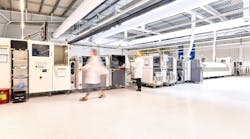The digital economy is no longer a future goal. Simply put, the pandemic changed the rules and the timeline. Organizations need to reach new levels of efficiency. They need remote access that goes beyond Zoom. And they need to be able truly envision the future.
Equipment manufacturer Lacroix Group has recognized the growing need. And, in partnership with global telecoms operator Orange, it is actively exploring the benefits of 5G at the its electronics plant in Montrevault-sur-Evre, France. Specialized in the electronic design and production of embedded systems and industrial connected objects, this smart factory is recognized as a window into the future of industry. It is running full-scale tests to see the benefits of 5G and its use in Industry 4.0 as part of the "Symbiose" project – the electronics factory of the future in France. As a tool for business recovery and transformation, 5G will enable manufacturers to develop the concept of a modular factory and improve the technical management of buildings.
Why 5G and in cooperation with Orange? Orange proposes co-innovation, meaning the companies can work together, not just using the technology, but trying to test the best use cases and innovate as a team to discover potential benefits for industry, Stéphane Gervais, executive vice president of strategic innovation at Lacroix Electronics tells IndustryWeek.
As part of the deployment, Orange designed and deployed an indoor 5G network based on Ericsson equipment including 4indoor 5G antennas (Ericsson Dot) installed inside the plant, broadcasting experimental frequencies to cover the production space. Orange is also operating a virtualized network core, distributed between the premises of Orange and the Lacroix Electronics plant. This enables local processing and data security, as well as network performance and efficiency, suitable for Lacroix Electronics use cases.
“We are taking a bit of a digital twin approach to this facility. For electronic manufacturing, we need to have highly flexible assembly lines where we can change set-ups from one line to the next, or tooling setups, and we need to monitor suppliers, vendors, market forecasts, etc. in real time,” he says. “Today, we don't have all the vital data sets in real time. But having access to this data should enable us to better address base yield and base efficiency in what we're going to do our manufacturing. It's about being informed enough to change the set up very quickly and adapt to quantity demands effectively.”
One of the primary challenges is to get all of the needed data in real time. “This is a big issue because we're talking about milliseconds. The fact that we get the right information and the right types allows for quick decision making. Not to stop the line because the component is missing or some materials are missing,” says Gervais. “The goal is leverage 5G to add more data to the mix as well. While our machines are providing basic data, we want to strategically add more sensors to get the vibration, temperatures and usage statistics of each machine to aid in maintenance prediction as well.”
Lacroix is also looking to test 5G in optimizing optical inspection. “There is currently a lot of manpower used to complete needed checks. We want to prove out the use case, which will also require leveraging AI to learn the algorithm about the default. This will require a high speed of connectivity with very low latency – the benefits 5G promises.” By taking high- resolution photos of electronic processes, for example, real-time verification of the quality of welds and the presence of components can be performed. Taking and sending images in real time can be combined with machine learning in order to improve detection algorithms and also ensure that there are no errors in the batches produced or if a readjustment of a machine is necessary.
In parallel to the 5G testing, Lacroix is also designing its own set of products for the mobility markets including traffic lights and street lighting for autonomous vehicles. "We are also providing IoT devices for remotely managing water networks, energy networks, etc. We are also working on minimizing the impact of our industry in terms of energy and CO2,” he says. “We improved an existing product to manage all the energy of our factory, controlling it in real time. Beyond using a few temperature sensors and assigning temperature and humidity levels, we want to implement more sensors to achieve granularity to optimize energy usage to the right time and place.”




